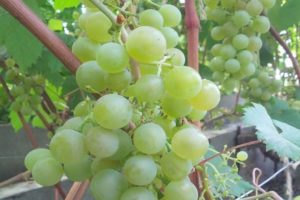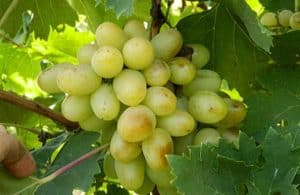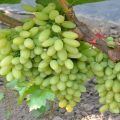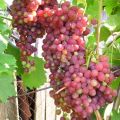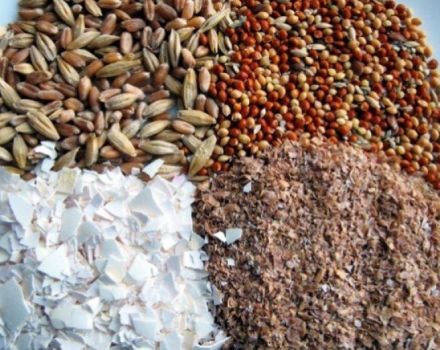Description of black Kishmish grapes, cultivation and varieties
Black Kishmish grapes have been in demand for many years. It is not difficult to grow a table sweet variety with small, invisible seeds in a temperate climate. Kishmish includes - flavonoids, vitamins A, C, folic acid, sucrose, glucose, fructose, fiber, minerals, essential oils, chlorophyll, quertecins. Caloric content 400 kcal per 100 g of product.
Origin of the variety
Kishmish means "dried grapes" from Persian. It is mentioned in the 13th century. His homeland is Central Asia and the Middle East, he appeared together with the Turkic tribes. Breeders noticed that there were no bones in it or there were very few of them and created new varieties based on Kishmish. There are also white, red, pink Kishmish.
Description and characteristics of black Kishmish grapes
The grapes of this variety are mid-season, table. The bush is vigorous, the length of the vine is up to 2-2.5 m. Its leaves are medium-sized, strongly dissected, three-lobed, dark green. The flowers are bisexual, emerald hue. The berries ripen 3 months after the beginning of flowering.
Bunches of the Kishmish variety are cylindrical, dense, weighing 300-700 g. The berries are not very large, oval, elongated at the top and slightly flattened at the bottom. One berry has a mass of 2.7-3 g, dark blue with a gray waxy bloom. The pulp is juicy. The taste is delicate, fruity, high sugar content, 22-27%.
Dark Kishmish is used in a fresh, dried form, compotes are made from berries, raisins are in demand in baked goods.

Pros and cons
Kishmish has a number of advantages:
- berries do not contain seeds;
- brings a large harvest - 250 centners per hectare;
- you can transport brushes over long distances;
- easy to care for, like other varieties;
- berries do not crack in rainy weather;
- used for the preparation of wines, dried fruits, soft drinks.
The disadvantages of the variety are intolerance to low temperatures, susceptibility to diseases - oidimum, anthracnose and attacks of pests - wasps, leaf rollers. After ripening, the berries must be removed immediately, otherwise they will lose their taste.
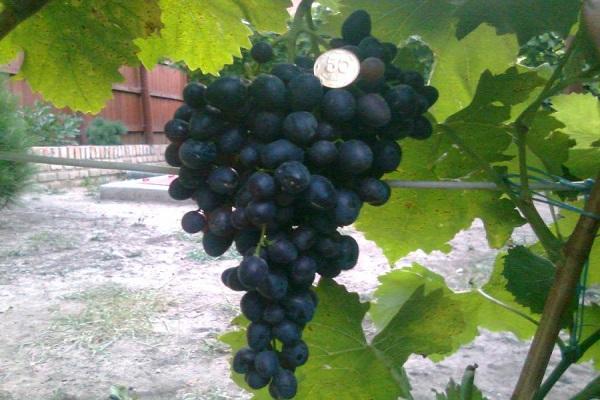
Growing features
They take into account the timing and choose the right place for the grape variety.
Planting period
Kishmish grapes are planted in autumn or spring, in cold regions it is advised to do this in spring. Over the summer, the root system will strengthen. In the south, this variety can be planted in the fall.They purchase material for planting in specialized stores, nurseries, where there is a guarantee.
Site preparation
A place for a perennial plant is chosen free, unshaded, protected from the wind. The best option is south, southwest with a slight slope.
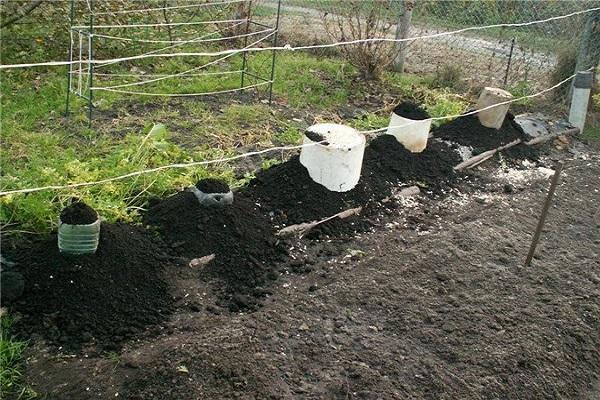
Sandy loam, loamy, black earth, chestnut soils are suitable for the Kishmish variety. The site is dug up in advance and humus is introduced - 3-4 kg per 1 sq. m and superphosphate - 100 g per 1 sq. m. Phosphorite flour is added to the acidic soil, coarse-grained sand is added to the clay soil.
Planting process
The grape bushes are planted at a distance of 2.5 m, between the rows - 3 m. The roots of the seedlings are cut, put in water for 1-2 days.
First, dig holes measuring 80 x 80 cm. Drainage from gravel is laid at the bottom. The earth is mixed with rotted manure, superphosphate, potassium salt. The seedling is installed, sprinkled with soil, leaving 2 eyes above the surface. Water using two buckets per bush. They put special supports - posts with stretched wire. The soil is mulched with straw, rotted sawdust.
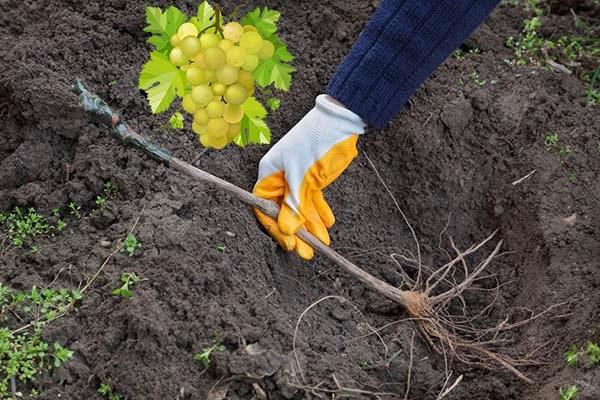
Specificity of plant care
In May, the grown grape vine is tied up, in June - pinched, the shoots are removed. In July, pinch the tops. The near-trunk circle is cleared of weeds, loosened. The bush is formed in different ways - in the form of a fan sleeve or formation on a trellis. Weak, sick, frozen shoots of grape varieties are removed in the spring.
Watering and fertilizing
Strong watering is not required for Kishmish. Every 4 days, 2-3 buckets of water are needed for a variety bush. It is better to apply drip irrigation. Watered in the spring before and after blooming shoots, during active growth. Do not water for 2 weeks before harvest.
Before the growing season, fertilizers with nitrogen are applied under the grape bush, then phosphorus-potassium fertilizers. In autumn, nitrogen fertilization of the grapes is not required, organic matter is introduced, then complex mineral mixtures.
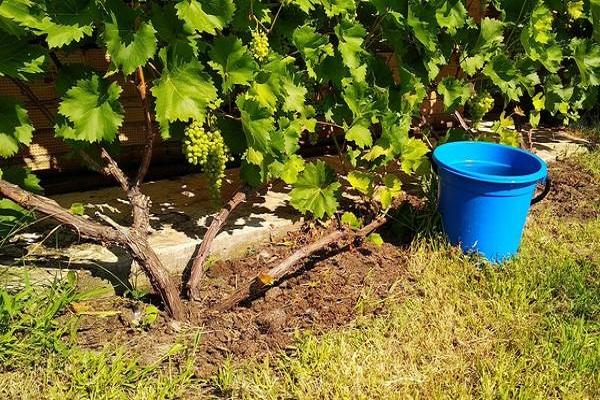
Preparing for the winter period
In the fall, the vine is pruned. The formation of a bush variety assumes 8-10 shoots per linear meter. Leave at least a meter between the sleeves.
After removing the berries and pruning before the onset of cold weather, the bushes are treated with solutions of iron and copper. Fallen leaves are removed.
To protect against cold weather, the vine is tied up and laid in dug trenches to a depth of 20 cm.
Sprinkle with soil, making a mound of 30 cm, or use agrofibre and create a canopy of branches. In addition, you can use straw, corn stalks.
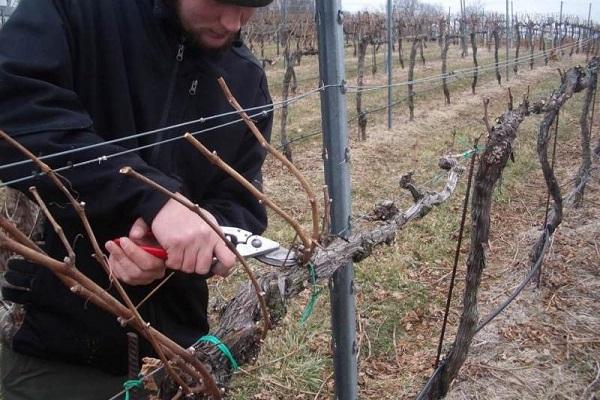
Description of diseases and pests
Grapes are often infected with diseases. For prophylaxis, you need to spray the bushes with Bordeaux liquid or take "Ridomil Gold". Multiplicity - three times per season. This is done in the fall, after the leaves have fallen, in early spring before bud break, during the growing season when the shoots reach 12-15 cm.
Oidium
Powdery mildew appears at first as small white spots on the buds. Then a white bloom forms, turning into brown spots with an irregular gray bloom and a moldy smell. Inflorescences stop growing, dry up, fall. If berries are affected, they burst, harden and rot. The vine is processed before and after flowering. Repeat after 20 days and in early August. Preparations for oidium - colloidal sulfur, "Stroby", "Vectra", "Tilt".
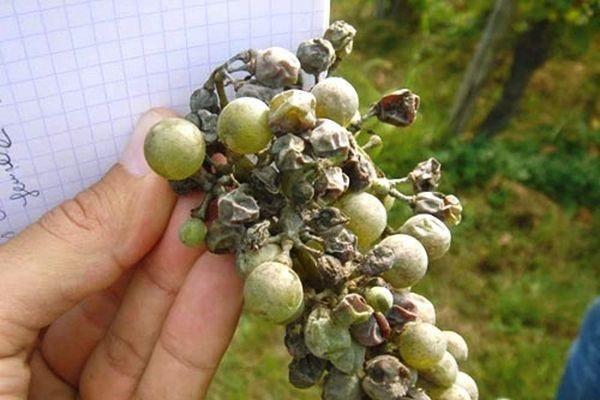
Mildew
Fungal spores germinate in wet weather. Leaves and veins have yellow oily spots. On the lower side there is a gray fluff, then it goes to buds, flowers. The berries turn brown, burst, and drain out of juice. The bushes need to be ventilated, the affected parts must be burned, treated with fungicides - copper oxychloride, "Poliram", "Thanos", when a fungus appears and for prevention.
Pests
The grape loves grapes. She feeds on ovaries, berries.When it appears, treatment with insecticides is needed.
To protect juicy berries from the invasion of wasps, they are driven away with smoke or special bags are put on each bunch. Place trap glasses with poisonous bait. In some cases, chemical treatment is used.

Harvesting and storage
The minimum harvest of Kishmish berries can be obtained in a year. Collect brushes in dry weather, in late August, early September. Berries are stored at a temperature of + 1 ... + 3 C in a dark, dry place with good ventilation. They keep the bunches on shelves of straw or in boxes.
Varieties of black kishmish
Kishmish has several varieties with excellent taste of berries and immunity.

Black finger
The second name is Black Finger, bred in Israel. The variety is distinguished by elongated large berries up to 3 cm long, weighing up to 14 g. Its clusters are 1-1.5 kg. The skin is firm. Has immunity to diseases, withstands frosts down to -20 C. Delicious, sugar content 20%. After the start of the growing season, it ripens in 150 days.
Black emerald
It is called Black Emerald. Early variety, American. From the beginning of the growing season, the berries ripen after 105 days, at the end of July. Bunches weighing 400-600 g, berries 3-6 g with dense pulp. Brushes weigh 500 g. Its yield is very high, but it is not resistant to diseases. Transfer temperature -23 FROM.
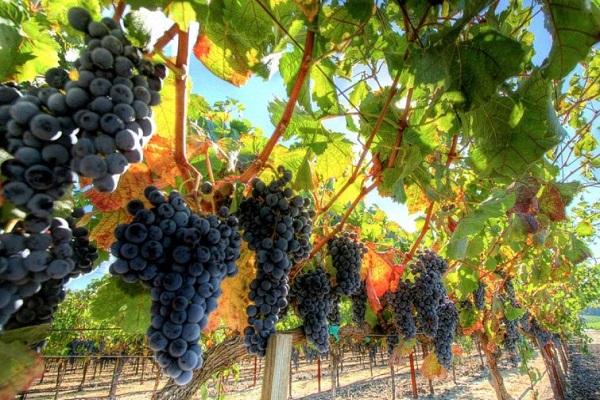
Black sultan
Derived from Glenoru and Talisman hybrids. An early variety, ripens 120 days after bud break. The bush is vigorous, pollination is not required, clusters weighing up to 700 g. Berries with a fruity aroma of 2-5 g. Sugar content of the variety is up to 24%. Withstands frosts down to -25 C. Has immunity to mildew, gray rot, powdery mildew.
